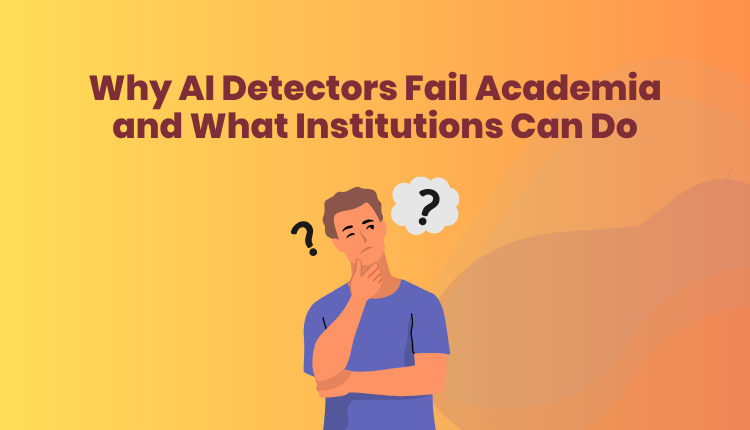The rapid integration of generative AI tools—like ChatGPT and DeepSeek—into academic workflows has left institutions and libraries struggling to uphold academic integrity. In response, many have adopted AI content detectors, hoping to curb misuse and restore trust in scholarly outputs.
But this surface-level fix is already cracking. Inconsistent results, increased faculty burden, and rising distrust between students and educators suggest a deeper problem. In one widely reported case, an entire class was penalized based solely on AI suspicion—despite students’ claims of original work. Across campuses, stories like these are becoming alarmingly common.
This raises a critical question for institutional leaders and librarians: Are we investing in a broken system?
In this article, we outline four key reasons why AI content detectors are falling short—and why a shift towards a more proactive approach that drives ethical AI literacy, student content ownership, and guided verification may be the more sustainable path forward.
1. AI Content Detectors Are Inaccurate, Inconsistent, and Easily Manipulated
AI content detectors operate by assigning a probability score to how “machine-like” a piece of writing appears, based on factors like repetitiveness, word predictability, and sentence structure. But this probabilistic approach has critical limitations.
Students have learned how to bypass detection using “humanizing” tools that rephrase AI output to resemble human writing. And multilingual students—whose writing may follow simpler or less idiomatic patterns—are often falsely flagged, leading to student distress and administrative disputes.
Critically, AI content detectors fail at both ends of the accuracy spectrum. They misclassify human-written text as AI (false positives) and miss actual AI-generated content (false negatives). OpenAI itself discontinued its AI detector in July 2023, citing a low accuracy rate of just 26%.
In short, the technology is neither reliable nor fair, and its continued use poses risks to equity, accuracy, and academic judgment.
2. Detection Ignores the Root Problem: Learning Is Being Outsourced
AI content detectors focus on identifying what was generated, but they do not reveal why students turn to AI in the first place. Students are turning to AI for answers and not for assistance. This trend is prevalent in high-pressure academic environments and especially where digital literacy is lacking. Between 2016 and 2020, over 40 million students across regions like China and Southeast Asia used AI in educational context.
This undermines critical thinking and erodes the purpose of education. Detection alone cannot reverse this trend. By focusing solely on outcomes, institutions risk missing an opportunity to intervene meaningfully. Without guidance on ethical AI use, students will continue to use these tools in ways that bypass the learning process.
Librarians and faculty must collaborate and help students navigate responsible AI integration.
3. Faculty Burnout Is a Hidden Cost of AI Policing
Detection tools are often promoted as a solution to reduce faculty stress. In reality, they add layers of scrutiny to the grading process. In a revealing episode of Talking Point by CNA Insider, the host conducted an experiment by submitting one AI-generated and one human-written assignment to popular detection tools. The result? Both were flagged, exposing the inconsistency and unreliability of such tools. (Watch here)
When AI content detectors flag the content as “possible AI-generated”, they rarely provide actionable insights. Faculty members are left to investigate students writing history and justify their decisions—putting them in the uncomfortable position of being both judge and enforcer.
This is where librarians and instructional technologists can play a crucial role: by advocating for AI literacy integration and reducing reliance on uncertain detection tools, institutions can free up faculty time for teaching rather than policing.
4. Built-In Bias and Evolving AI Models Undermine Fairness
Detection algorithms rely on training data that often reinforce linguistic and cultural biases. English as a Second Language (ESL) students—whose writing may seem “generic” or overly simplified—are especially vulnerable to false positives. A 2023 study by Stanford University researchers strongly cautioned against the use of AI content detectors when assessing work by non-native English speakers.
Adding to the complexity, generative AI models evolve rapidly. Each new iteration is better at mimicking human writing, further reducing the effectiveness of current detection systems. Detectors built on outdated assumptions cannot keep up with these advancements.
The result is an uneven playing field where bias challenge educational fairness and trust.
The Sustainable Solution: Track the Writing Process
Instead of policing the final submission, institutions should focus on the writing journey. A process-based verification system emphasizes transparency, ethical use, and accountability throughout the writing process.
One such proactive approach is Trinka’s DocuMark, which integrates directly into the institute’s Learning Management Systems (LMS). Instead of merely analyzing the final text, this approach documents and verifies the writing journey:
- Drafting assignments and submission with version history
- Guided verification of AI-generated content by students for revision
- Transparent authorship tracking to demonstrate content ownership
- Analysis and verification reports for faculty for decision-making
This system allows faculty to offer feedback and request revisions, rather than resorting to punitive action. The emphasis shifts from suspicion to support, from enforcement to education.
Why This Matters for Institutions and Librarians?
For institutional leaders and librarians, the path forward is clear: AI content detectors are not a scalable, reliable, solution. While they may offer a short-term fix, they do not promote sustainable academic values.
Academic integrity isn’t just about stopping misconduct, or surveillance—it’s about support. Tools like DocuMark represent more than just technology. It shows how the student got there giving both faculty and students clarity, confidence, and context.
Explore how DocuMark empowers faculty and students to use AI responsibly and strengthen academic integrity.
Book a demo today!

